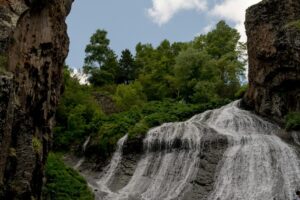Zorats Karer, also known as Karahunj or Carahunge, is a fascinating archaeological site located near the city of Sisian in the Syunik province of Armenia. This site, situated on a rocky promontory, is home to approximately 223 large stone tombs, offering a glimpse into the ancient history of the region.

Explored by a team of archaeologists from the Institut fur Vorderasiatische Archaologie, University of Munich, their findings published in 2000 shed light on the true nature of Zorats Karer. Contrary to the popular belief that it may be an Armenian Stonehenge, the researchers concluded that it was primarily a necropolis, serving as a burial site from the Middle Bronze Age to the Iron Age. Additionally, they suggest that it may have also functioned as a place of refuge during times of war, possibly in the Hellenistic-Roman period.
One of the most striking features of Zorats Karer is the wall of rocks and compacted soil that surrounds the site. Originally built for reinforcement, only the upright rocks remain today. Among these stones, about 84 feature circular holes, although only around 50 of them have survived. These peculiar holes have captured the interest of Russian and Armenian archaeo-astronomists, who propose that they could have been used for astronomical observation.
The theory of astronomical usage is supported by the alignment of four stone holes, which observers claim point to the spot on the horizon where the sun rises on midsummer’s day. Similarly, four other standing stones display holes that align with the point where the sun sets on the same day. However, it is important to note that the true purpose of these holes remains speculative, as they are relatively unweathered and may not even be of prehistoric origin.
For those interested in delving deeper into the mysteries of Zorats Karer, a visit to the small museum in the nearby city of Sisian is a must. The museum showcases various findings from the area, including paleolithic petroglyphs found on mountain tops and grave artifacts from the Bronze Age burial site, which boasts over 200 shaft graves.
In 2004, the site was officially named the Karahunj (Carahunge) Observatory by parliamentary decree, recognizing its potential astronomical significance. Over the years, numerous research expeditions have been conducted to study Zorats Karer. Paris Herouni and Elma Parsamyan of Biurakan Observatory have been at the forefront of extensive research, offering valuable insights into the site.
According to Herouni, Zorats Karer was not just a necropolis but also a temple with a large and developed observatory, serving as a center of learning. He believes that the temple was dedicated to the Armenian sun-god Ari. Through his survey of the site, Herouni estimated its age to be around 7600-4500 years old.
Herouni also proposed an intriguing hypothesis that some of the stones at the monument mirror the Cygnus constellation’s biggest star, Deneb. This theory gains further support from a stone discovered in Gobekli Tepe, Turkey, which depicts the map of the night sky, specifically the Cygnus constellation. The resemblance between this stone and the Zorats Karer site, as noted by V. Vahradyan, adds another layer of fascination to this ancient observatory.
In conclusion, Zorats Karer offers a captivating journey into Armenia’s ancient past. Whether it served as a necropolis, a place of refuge, or an observatory, the site’s enigmatic stone tombs and astronomical alignments continue to intrigue researchers and visitors alike. Exploring the mysteries of Zorats Karer provides a unique opportunity to connect with the rich history and cultural heritage of this remarkable region.



